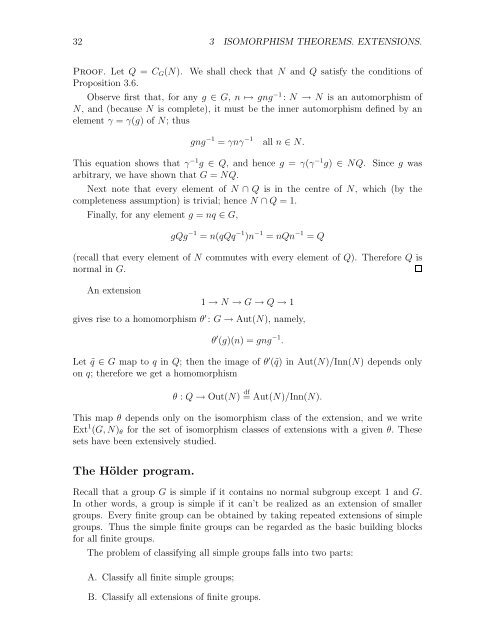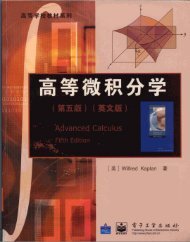Milne - Group Theory.. - Free
Milne - Group Theory.. - Free
Milne - Group Theory.. - Free
You also want an ePaper? Increase the reach of your titles
YUMPU automatically turns print PDFs into web optimized ePapers that Google loves.
32 3 ISOMORPHISM THEOREMS. EXTENSIONS.<br />
Proof. Let Q = C G (N). We shall check that N and Q satisfy the conditions of<br />
Proposition 3.6.<br />
Observe first that, for any g ∈ G, n ↦→ gng −1 : N → N is an automorphism of<br />
N, and (because N is complete), it must be the inner automorphism defined by an<br />
element γ = γ(g) ofN; thus<br />
gng −1 = γnγ −1 all n ∈ N.<br />
This equation shows that γ −1 g ∈ Q, and hence g = γ(γ −1 g) ∈ NQ. Since g was<br />
arbitrary, we have shown that G = NQ.<br />
Next note that every element of N ∩ Q is in the centre of N, wh ich (by th e<br />
completeness assumption) is trivial; hence N ∩ Q =1.<br />
Finally, for any element g = nq ∈ G,<br />
gQg −1 = n(qQq −1 )n −1 = nQn −1 = Q<br />
(recall that every element of N commutes withevery element of Q). Therefore Q is<br />
normal in G.<br />
An extension<br />
1 → N → G → Q → 1<br />
gives rise to a homomorphism θ ′ : G → Aut(N), namely,<br />
θ ′ (g)(n) =gng −1 .<br />
Let ˜q ∈ G map to q in Q; then the image of θ ′ (˜q) inAut(N)/Inn(N) depends only<br />
on q; therefore we get a homomorphism<br />
θ : Q → Out(N) df<br />
=Aut(N)/Inn(N).<br />
This map θ depends only on the isomorphism class of the extension, and we write<br />
Ext 1 (G, N) θ for the set of isomorphism classes of extensions with a given θ. These<br />
sets have been extensively studied.<br />
The Hölder program.<br />
Recall that a group G is simple if it contains no normal subgroup except 1 and G.<br />
In other words, a group is simple if it can’t be realized as an extension of smaller<br />
groups. Every finite group can be obtained by taking repeated extensions of simple<br />
groups. Thus the simple finite groups can be regarded as the basic building blocks<br />
for all finite groups.<br />
The problem of classifying all simple groups falls into two parts:<br />
A. Classify all finite simple groups;<br />
B. Classify all extensions of finite groups.

















